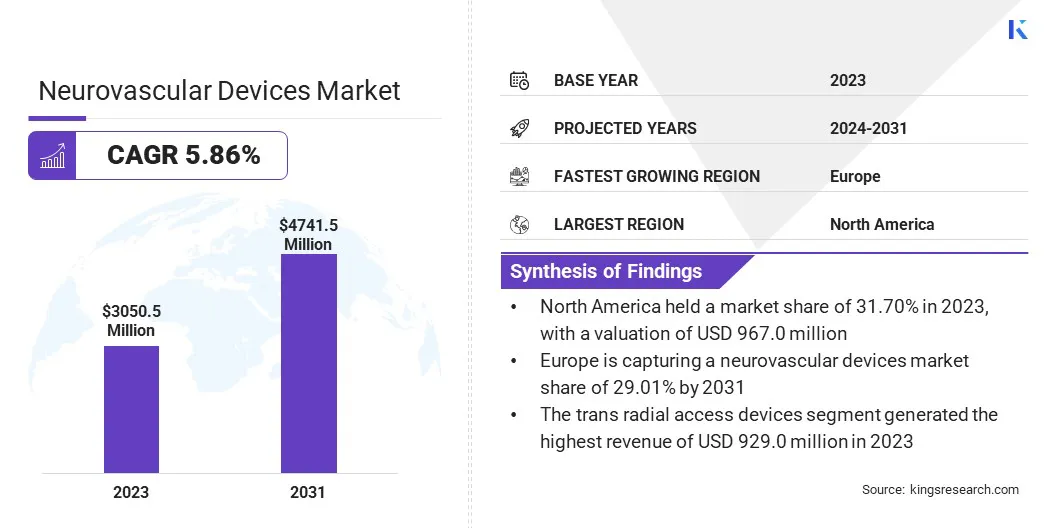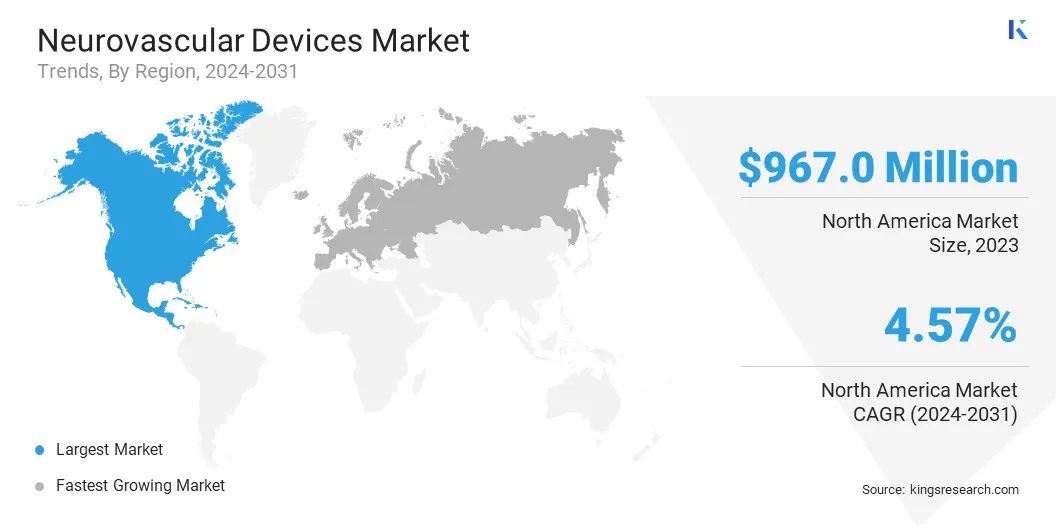Neurovascular Devices Market Size
The global Neurovascular Devices Market size was valued at USD 3,050.5 million in 2023 and is projected to reach USD 4,741.5 million by 2031, growing at a CAGR of 5.86% from 2024 to 2031. In the scope of work, the report includes products offered by companies such as Stryker, Medtronic, Penumbra, Inc., MicroPort Medical (Group) Co., Ltd., Terumo Corporation, Braun SE, Acandis GmbH, L. Gore & Associates, Inc., Integra LifeSciences Corporation, Abbott and Others. A paradigm shift toward patient-centric care and personalized treatment approaches is fostering market growth.
Advancements in medical technology, including the integration of artificial intelligence and machine learning algorithms, are projected to stimulate market expansion. Healthcare providers are offering tailored solutions for neurovascular conditions. This personalized approach is enhancing treatment outcomes and improving patient satisfaction and compliance with healthcare regulations globally.
Additionally, the market is experiencing a surge in the demand for neurovascular devices in emerging economies due to increasing healthcare infrastructure development and growing awareness regarding neurological disorders.
Manufacturers are capitalizing on this trend by expanding their presence in untapped markets and introducing affordable yet innovative products tailored to the specific needs of these regions. Furthermore, strategic partnerships between industry players and healthcare providers are driving collaborative research initiatives, leading to the development of breakthrough neurovascular therapies and devices.
The neurovascular devices market encompasses medical devices utilized in the diagnosis, treatment, and management of conditions affecting the blood vessels of the brain and spinal cord. These devices include embolization coils, stents, thrombectomy devices, catheters, and flow diversion devices.
Increasing occurrences of neurovascular diseases such as ischemic strokes, brain aneurysms, and arteriovenous malformations (AVMs) are driving the demand for these devices. Technological advancements and demographic trends, particularly the aging population, are key factors shaping the market landscape.

Analyst’s Review
The neurovascular devices market is witnessing significant growth fueled by advancing medical technology and rising incidences of neurovascular diseases globally. Technological innovations, including minimally invasive procedures and next-generation materials, are reshaping treatment paradigms, offering safer and more effective solutions. However, market growth is likely to be hindered by regulatory challenges and reimbursement limitations.
Additionally, the market faces competition from alternative treatment modalities and emerging technologies. Market players are focusing on Strategic collaborations, investments in research and development, and geographic expansion efforts to capitalize on growth opportunities and address evolving patient needs.
Neurovascular Devices Market Growth Factors
The neurovascular devices market is poised to witness significant expansion over the review period driven by the expanding aging population, with an increased prevalence of neurovascular diseases such as stroke and aneurysms. This is leading to a rise in the demand for neurovascular devices for both diagnosis and treatment. Moreover, government initiatives aimed at stroke awareness play a crucial role in driving market growth.
Public health campaigns and educational programs designed to promote early recognition of stroke symptoms and the importance of prompt intervention are likely to result in a higher number of patients seeking medical assistance. This increased awareness among individuals is fueling demand for neurovascular devices utilized in stroke diagnosis and intervention, thereby supporting market expansion.
Stringent regulatory requirements pose a notable challenge to market expansion. Neurovascular devices are subject to rigorous regulatory scrutiny to ensure patient safety and device efficacy. Compliance with these requirements entails significant investments of time and resources, often resulting in delays in product approvals and market entry. As a result, manufacturers face obstacles in introducing innovative devices to meet the growing demand for advanced neurovascular solutions.
Despite regulatory challenges, the market presents opportunities for growth and innovation. Manufacturers are leveraging advancements in medical technology to develop novel neurovascular devices that address unmet clinical needs and enhance patient outcomes. For instance, the integration of advanced imaging techniques and robotic-assisted procedures has the potential to revolutionize neurovascular interventions, offering greater precision and improved patient safety.
Neurovascular Devices Market Trends
The neurovascular devices market is experiencing notable shifts driven by the growing adoption of personalized medicine approaches for targeted interventions. Advancements in imaging and diagnostic tools enable healthcare providers to tailor neurovascular treatments to individual patient characteristics, including stroke location and blood vessel anatomy.
This has led to the development of specialized neurovascular devices, such as anatomically tailored stents and embolic coils, designed to address specific vascular configurations. These specialized devices enhance treatment efficacy and minimize complications, thereby contributing to the increasing demand for neurovascular products that cater to personalized treatment needs.
Moreover, the integration of remote monitoring technologies and data analytics is another significant factor shaping the neurovascular devices market landscape. Remote monitoring enables healthcare professionals to track patient progress post-intervention, leading to better patient management and potentially lower readmission rates.
As healthcare systems increasingly prioritize patient-centered care and data-driven decision-making, the demand for such advanced monitoring solutions is expected to rise in the forthcoming years, driving further innovation in the market.
- For instance, Medtronic's ‘Solitaire™ Revascularization’ device incorporates advanced imaging techniques and personalized treatment approaches, allowing physicians to precisely target occluded blood vessels in stroke patients, resulting in improved outcomes and reduced long-term disability. This exemplifies the growing trend toward personalized medicine in neurovascular interventions.
Segmentation Analysis
The global neurovascular devices market is segmented based on product type, application, and geography.
By Device Type
Based on device type, the market is categorized into trans radial access devices, neurothrombectomy devices, cerebral angioplasty & stenting systems, cerebral embolization & aneurysm coiling devices, and support devices.
The trans radial access devices segment generated the highest revenue of USD 929.0 million in 2023. This dominance is attributed to the advantages offered by trans radial access devices viz., reduced procedure-related complications, shorter recovery times, and improved patient comfort compared to traditional approaches.
Moreover, advancements in device design and technology have enhanced the safety and efficacy of trans radial access procedures, thereby fostering their adoption among healthcare providers. Additionally, rising awareness among physicians regarding the benefits of trans radial access for neurovascular interventions is fueling the growth of the segment.
By Application
Based on application, the market is divided into cerebral aneurysm, ischemic strokes, carotid artery stenosis, and others. The cerebral aneurysm segment captured the largest market share of 38.11% in 2023.
The increasing prevalence of cerebral aneurysms globally necessitates the use of neurovascular devices for diagnosis and treatment. Advancements in imaging technologies have improved the detection and characterization of cerebral aneurysms, leading to an increase in the demand for specialized devices such as embolization coils and flow diversion systems for endovascular treatment.
Moreover, a notable shift toward minimally invasive procedures for cerebral aneurysm repair has bolstered the adoption of neurothrombectomy devices and stenting systems, thus contributing to the dominance of the segment.
By End User
Based on end user, the market is classified into hospitals, specialty care centers, and others. The hospitals segment is projected to dominate the neurovascular devices market over the forecast period, garnering a revenue of USD 3,058.7 million by 2031.
Hospitals are equipped with dedicated neurovascular departments that have advanced imaging facilities and specialized surgical suites, facilitating comprehensive care for patients with conditions such as ischemic strokes and cerebral aneurysms.
Moreover, the increasing prevalence of neurovascular diseases globally has led to a greater demand for neurovascular interventions, thereby stimulation hospitals to procure relevant devices. Additionally, collaborations between hospitals and medical device manufacturers for research and training purposes bolster segmental growth.
Neurovascular Devices Market Regional Analysis
Based on region, the global market is classified into North America, Europe, Asia-Pacific, MEA, and Latin America.

The North America Neurovascular Devices Market share stood around 31.70% in 2023 in the global market, with a valuation of USD 967.0 million. Surging preference for minimally invasive procedures, along with technological advancements, is driving the demand for innovative neurovascular devices in the region.
Moreover, the rising prevalence of neurovascular diseases in the region necessitates the development of advanced diagnostic and treatment options, thereby fostering market growth. The well-developed healthcare infrastructure and favorable reimbursement policies are further supporting regional market expansion.
Additionally, the growing adoption of tele-neurovascular interventions is addressing the challenge of access to stroke care in remote areas, thereby expanding the market's reach. Furthermore, the region's growing emphasis on value-based care is impelling the demand for cost-effective neurovascular devices, prompting manufacturers to prioritize affordability and efficacy in product development.
Europe is anticipated to witness substantial growth in the upcoming years, capturing a neurovascular devices market share of 29.01% by 2031. The increasing awareness of stroke symptoms and the importance of early intervention are boosting the demand for neurovascular devices tailored to diagnosis and treatment in the region.
The region's expanding geriatric population, along with advancements in healthcare technologies, is leading to a rise in the need for innovative solutions to address age-related neurological conditions. Moreover, growing investments in advanced healthcare technologies are stimulating market growth by facilitating the adoption of state-of-the-art neurovascular devices.
Furthermore, Europe is witnessing a notable trend toward personalized medicine approaches for stroke treatment, leveraging advancements in diagnostics and treatment modalities to tailor interventions to individual patient needs. Additionally, the integration of digital tools such as AI-powered surgical navigation systems is enhancing the precision and efficacy of neurovascular interventions, thereby contributing significantly to regional market expansion.
Competitive Landscape
The neurovascular devices market report will provide valuable insight with an emphasis on the fragmented nature of the industry. Prominent players are focusing on several key business strategies such as partnerships, mergers and acquisitions, product innovations, and joint ventures to expand their product portfolio and increase their market shares across different regions.
Manufacturers are adopting a range of strategic initiatives, including investments in R&D activities, the establishment of new manufacturing facilities, and supply chain optimization, to strengthen their market standing.
List of Key Companies in Neurovascular Devices Market
- Stryker
- Medtronic
- Penumbra, Inc.
- MicroPort Medical (Group) Co., Ltd.
- Terumo Corporation
- Braun SE
- Acandis GmbH
- L. Gore & Associates, Inc.
- Integra LifeSciences Corporation
- Abbott
Key Industry Developments
June 2023 (Acquisition) - Translumina, a medical technology company, has completed the acquisition of Blue Medical Devices, a Netherlands-based firm. With this acquisition, Translumina gains access to Blue Medical's innovative drug application technology in other product lines including neurovascular solutions.
The global neurovascular devices market is segmented as:
By Device Type
- Trans Radial Access Devices
- Neurothrombectomy Devices
- Cerebral Angioplasty & Stenting Systems
- Cerebral Embolization & Aneurysm Coiling Devices
- Support Devices
By Application
- Cerebral Aneurysm
- Ischemic Strokes
- Carotid Artery Stenosis
- Others
By End User
- Hospitals
- Speciality Care Centres
- Others
By Region
- North America
- Europe
- France
- U.K.
- Spain
- Germany
- Italy
- Russia
- Rest of Europe
- Asia-Pacific
- China
- Japan
- India
- South Korea
- Rest of Asia-Pacific
- Middle East & Africa
- GCC
- North Africa
- South Africa
- Rest of Middle East & Africa
- Latin America
- Brazil
- Argentina
- Rest of Latin America


